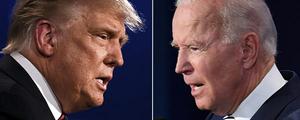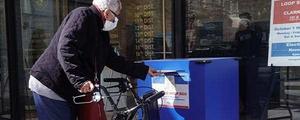Story Highlights
- Joe Biden leads Donald Trump in favorability, 54% to 47%
- Trump's rating up from 2016; Biden's exceeds Hillary Clinton's in 2016
- 2020 ratings still low on historical basis
WASHINGTON, D.C. -- Former Vice President Joe Biden leads President Donald Trump 54% to 47% in Gallup's historical "scalometer" measure of candidate favorability. Trump's 2020 rating on the zero to 10 scale is better than the all-time low 36% he received in 2016, and Biden's rating exceeds Hillary Clinton's 47% that year. Nevertheless, the 2020 ratings are among the lowest in Gallup's trends since 1956.
| Nominee | Total favorable | Total unfavorable | Net favorable | ||||||||||||||||||||||||||||||||||||||||||||||||||||||||||||||||||||||||||||||||||||||||||||||||
|---|---|---|---|---|---|---|---|---|---|---|---|---|---|---|---|---|---|---|---|---|---|---|---|---|---|---|---|---|---|---|---|---|---|---|---|---|---|---|---|---|---|---|---|---|---|---|---|---|---|---|---|---|---|---|---|---|---|---|---|---|---|---|---|---|---|---|---|---|---|---|---|---|---|---|---|---|---|---|---|---|---|---|---|---|---|---|---|---|---|---|---|---|---|---|---|---|---|---|---|
| % (+1 to +5) | % (-1 to -5) | +/- | |||||||||||||||||||||||||||||||||||||||||||||||||||||||||||||||||||||||||||||||||||||||||||||||||
| 1956 Oct 18-23 | D. Eisenhower | 84 | 12 | +72 | |||||||||||||||||||||||||||||||||||||||||||||||||||||||||||||||||||||||||||||||||||||||||||||||
| 1964 Oct 8-13 | L. Johnson | 81 | 13 | +68 | |||||||||||||||||||||||||||||||||||||||||||||||||||||||||||||||||||||||||||||||||||||||||||||||
| 1960 Oct 18-23 | J. Kennedy | 80 | 14 | +66 | |||||||||||||||||||||||||||||||||||||||||||||||||||||||||||||||||||||||||||||||||||||||||||||||
| 1976 Sep 24-27 | J. Carter | 81 | 16 | +65 | |||||||||||||||||||||||||||||||||||||||||||||||||||||||||||||||||||||||||||||||||||||||||||||||
| 1960 Oct 18-23 | R. Nixon | 79 | 16 | +63 | |||||||||||||||||||||||||||||||||||||||||||||||||||||||||||||||||||||||||||||||||||||||||||||||
| 1976 Sep 24-27 | G. Ford | 78 | 20 | +58 | |||||||||||||||||||||||||||||||||||||||||||||||||||||||||||||||||||||||||||||||||||||||||||||||
| 1968 Oct 17-22 | R. Nixon | 79 | 22 | +57 | |||||||||||||||||||||||||||||||||||||||||||||||||||||||||||||||||||||||||||||||||||||||||||||||
| 1972 Oct 13-16 | R. Nixon | 76 | 21 | +55 | |||||||||||||||||||||||||||||||||||||||||||||||||||||||||||||||||||||||||||||||||||||||||||||||
| 1968 Oct 17-22 | H. Humphrey | 72 | 28 | +44 | |||||||||||||||||||||||||||||||||||||||||||||||||||||||||||||||||||||||||||||||||||||||||||||||
| 1984 Sep 21-24 | R. Reagan | 71 | 30 | +41 | |||||||||||||||||||||||||||||||||||||||||||||||||||||||||||||||||||||||||||||||||||||||||||||||
| 1980 Oct 10-13 | J. Carter | 68 | 32 | +36 | |||||||||||||||||||||||||||||||||||||||||||||||||||||||||||||||||||||||||||||||||||||||||||||||
| 1984 Sep 21-24 | W. Mondale | 66 | 34 | +32 | |||||||||||||||||||||||||||||||||||||||||||||||||||||||||||||||||||||||||||||||||||||||||||||||
| 1992 Oct 23-25 | B. Clinton | 64 | 33 | +31 | |||||||||||||||||||||||||||||||||||||||||||||||||||||||||||||||||||||||||||||||||||||||||||||||
| 1956 Oct 18-23 | A. Stevenson | 61 | 31 | +30 | |||||||||||||||||||||||||||||||||||||||||||||||||||||||||||||||||||||||||||||||||||||||||||||||
| 2008 Oct 23-26 | J. McCain | 63 | 35 | +28 | |||||||||||||||||||||||||||||||||||||||||||||||||||||||||||||||||||||||||||||||||||||||||||||||
| 1980 Oct 10-13 | R. Reagan | 64 | 37 | +27 | |||||||||||||||||||||||||||||||||||||||||||||||||||||||||||||||||||||||||||||||||||||||||||||||
| 2008 Oct 23-26 | B. Obama | 62 | 35 | +27 | |||||||||||||||||||||||||||||||||||||||||||||||||||||||||||||||||||||||||||||||||||||||||||||||
| 2012 Oct 27-28 | B. Obama | 62 | 37 | +25 | |||||||||||||||||||||||||||||||||||||||||||||||||||||||||||||||||||||||||||||||||||||||||||||||
| 2004 Oct 22-24 | G.W. Bush | 61 | 39 | +22 | |||||||||||||||||||||||||||||||||||||||||||||||||||||||||||||||||||||||||||||||||||||||||||||||
| 1992 Oct 23-25 | G.H.W. Bush | 59 | 40 | +19 | |||||||||||||||||||||||||||||||||||||||||||||||||||||||||||||||||||||||||||||||||||||||||||||||
| 2004 Oct 22-24 | J. Kerry | 57 | 40 | +17 | |||||||||||||||||||||||||||||||||||||||||||||||||||||||||||||||||||||||||||||||||||||||||||||||
| 1972 Oct 13-16 | G. McGovern | 55 | 41 | +14 | |||||||||||||||||||||||||||||||||||||||||||||||||||||||||||||||||||||||||||||||||||||||||||||||
| 2012 Oct 27-28 | M. Romney | 55 | 43 | +12 | |||||||||||||||||||||||||||||||||||||||||||||||||||||||||||||||||||||||||||||||||||||||||||||||
| 2020 Sep 30-Oct 15 | J. Biden | 54 | 43 | +11 | |||||||||||||||||||||||||||||||||||||||||||||||||||||||||||||||||||||||||||||||||||||||||||||||
| 1964 Oct 8-13 | B. Goldwater | 43 | 47 | -4 | |||||||||||||||||||||||||||||||||||||||||||||||||||||||||||||||||||||||||||||||||||||||||||||||
| 2020 Sep 30-Oct 15 | D. Trump | 47 | 51 | -4 | |||||||||||||||||||||||||||||||||||||||||||||||||||||||||||||||||||||||||||||||||||||||||||||||
| 2016 Nov 2-5 | H. Clinton | 47 | 52 | -5 | |||||||||||||||||||||||||||||||||||||||||||||||||||||||||||||||||||||||||||||||||||||||||||||||
| 2016 Nov 2-5 | D. Trump | 36 | 61 | -25 | |||||||||||||||||||||||||||||||||||||||||||||||||||||||||||||||||||||||||||||||||||||||||||||||
| Based on U.S. adults. No data for 1988, 1996 and 2000 | |||||||||||||||||||||||||||||||||||||||||||||||||||||||||||||||||||||||||||||||||||||||||||||||||||
| Gallup | |||||||||||||||||||||||||||||||||||||||||||||||||||||||||||||||||||||||||||||||||||||||||||||||||||
Gallup's "scalometer" rating format asks respondents to share their views of people in the news using a score from +1 to +5 to indicate degrees of favorability toward a person (with +5 being highly favorable) and from -1 to -5 to indicate degrees of negative opinion (with -5 being highly unfavorable).
Gallup asked this question routinely prior to 1992 to measure the images of U.S. public figures. Since then, the question has been used only occasionally for the president and presidential candidates to allow for key historical comparisons.
Most presidential candidates from the 1950s to the 1970s enjoyed 70% or better favorable ratings on this measure, with several at 80% or higher. The ratings largely remained above 60% through 2012 before plummeting in 2016. The few candidates performing below par for their respective eras -- Barry Goldwater in 1964, George McGovern in 1972, George H.W. Bush in 1992, John Kerry in 2004 and Mitt Romney in 2012 -- all lost.
The latest results are based on a national Gallup telephone poll conducted Sept. 30-Oct. 15.
As is typical for the scalometer measure, both candidates this year are rated better on the favorability scalometer than on the binary favorable/unfavorable rating that Gallup relies on more frequently. Gallup's most recent standard favorable ratings of the 2020 candidates, based on an Aug. 31-Sept. 13 poll, put Trump at 41% and Biden at 46%.
Trump Better Liked Than in 2016, but Deficit With Opponent Unchanged
As noted, Trump is viewed more favorably than he was four years ago when he and the Democratic nominee, Sen. Hillary Clinton, achieved the dubious distinction of being the least favorably viewed presidential candidates in the history of Gallup polling.
In November 2016, 36% of U.S. adults viewed Trump favorably on the scalometer question and 61% unfavorably, resulting in a -25 net-favorable score. That compares with his -4 net favorable rating today. Clinton's net favorable image in November 2016 was better than Trump's, but still negative by five points, with 47% viewing her favorably and 52% unfavorably.
Before 2016, no presidential candidate had been viewed unfavorably on the Gallup scalometer by a majority of Americans, although Goldwater came close in 1964 with his 43% favorable and 47% unfavorable ratings. However, Goldwater was the only candidate prior to Trump and Clinton who had a higher unfavorable than favorable rating.
Although Trump's image has since improved, he now faces an opponent with a significantly better image than Clinton's in 2016. As such, there continues to be a sizeable gap between Trump's net favorable score and his Democratic opponent's: -4 for Trump today and +11 for Biden vs. -25 for Trump in 2016 and -5 for Clinton.
Most Incumbents Have Led Their Opponent in Favorability -- and Won
Trump heads toward this year's election day as only the second incumbent in Gallup trends to trail his opponent in favorability -- the other being George H.W. Bush in 1992, and Bush lost that election to Bill Clinton. The only other incumbent to lose reelection in this era -- Jimmy Carter, in 1980 -- had a slight edge in favorability over his challenger, Ronald Reagan.
| Total favorable | Total unfavorable | |||||||||||||||||||||||||||||||||||||||||||||||||||||||||||||||||||||||||||||||||||||||||||||||||||
|---|---|---|---|---|---|---|---|---|---|---|---|---|---|---|---|---|---|---|---|---|---|---|---|---|---|---|---|---|---|---|---|---|---|---|---|---|---|---|---|---|---|---|---|---|---|---|---|---|---|---|---|---|---|---|---|---|---|---|---|---|---|---|---|---|---|---|---|---|---|---|---|---|---|---|---|---|---|---|---|---|---|---|---|---|---|---|---|---|---|---|---|---|---|---|---|---|---|---|---|---|
| % (+1 to +5) | % (-1 to -5) | |||||||||||||||||||||||||||||||||||||||||||||||||||||||||||||||||||||||||||||||||||||||||||||||||||
| 1956 | ||||||||||||||||||||||||||||||||||||||||||||||||||||||||||||||||||||||||||||||||||||||||||||||||||||
| D. Eisenhower | 84 | 12 | ||||||||||||||||||||||||||||||||||||||||||||||||||||||||||||||||||||||||||||||||||||||||||||||||||
| A. Stevenson | 61 | 31 | ||||||||||||||||||||||||||||||||||||||||||||||||||||||||||||||||||||||||||||||||||||||||||||||||||
| 1964 | ||||||||||||||||||||||||||||||||||||||||||||||||||||||||||||||||||||||||||||||||||||||||||||||||||||
| L. Johnson | 81 | 13 | ||||||||||||||||||||||||||||||||||||||||||||||||||||||||||||||||||||||||||||||||||||||||||||||||||
| B. Goldwater | 43 | 47 | ||||||||||||||||||||||||||||||||||||||||||||||||||||||||||||||||||||||||||||||||||||||||||||||||||
| 1972 | ||||||||||||||||||||||||||||||||||||||||||||||||||||||||||||||||||||||||||||||||||||||||||||||||||||
| R. Nixon | 76 | 21 | ||||||||||||||||||||||||||||||||||||||||||||||||||||||||||||||||||||||||||||||||||||||||||||||||||
| G. McGovern | 55 | 41 | ||||||||||||||||||||||||||||||||||||||||||||||||||||||||||||||||||||||||||||||||||||||||||||||||||
| 1980 | ||||||||||||||||||||||||||||||||||||||||||||||||||||||||||||||||||||||||||||||||||||||||||||||||||||
| J. Carter | 68 | 32 | ||||||||||||||||||||||||||||||||||||||||||||||||||||||||||||||||||||||||||||||||||||||||||||||||||
| R. Reagan | 64 | 37 | ||||||||||||||||||||||||||||||||||||||||||||||||||||||||||||||||||||||||||||||||||||||||||||||||||
| 1984 | ||||||||||||||||||||||||||||||||||||||||||||||||||||||||||||||||||||||||||||||||||||||||||||||||||||
| R. Reagan | 71 | 30 | ||||||||||||||||||||||||||||||||||||||||||||||||||||||||||||||||||||||||||||||||||||||||||||||||||
| W. Mondale | 66 | 34 | ||||||||||||||||||||||||||||||||||||||||||||||||||||||||||||||||||||||||||||||||||||||||||||||||||
| 1992 | ||||||||||||||||||||||||||||||||||||||||||||||||||||||||||||||||||||||||||||||||||||||||||||||||||||
| G.H.W. Bush | 59 | 40 | ||||||||||||||||||||||||||||||||||||||||||||||||||||||||||||||||||||||||||||||||||||||||||||||||||
| B. Clinton | 64 | 33 | ||||||||||||||||||||||||||||||||||||||||||||||||||||||||||||||||||||||||||||||||||||||||||||||||||
| 2004 | ||||||||||||||||||||||||||||||||||||||||||||||||||||||||||||||||||||||||||||||||||||||||||||||||||||
| G.W. Bush | 61 | 39 | ||||||||||||||||||||||||||||||||||||||||||||||||||||||||||||||||||||||||||||||||||||||||||||||||||
| J. Kerry | 57 | 40 | ||||||||||||||||||||||||||||||||||||||||||||||||||||||||||||||||||||||||||||||||||||||||||||||||||
| 2012 | ||||||||||||||||||||||||||||||||||||||||||||||||||||||||||||||||||||||||||||||||||||||||||||||||||||
| B. Obama | 62 | 37 | ||||||||||||||||||||||||||||||||||||||||||||||||||||||||||||||||||||||||||||||||||||||||||||||||||
| M. Romney | 55 | 43 | ||||||||||||||||||||||||||||||||||||||||||||||||||||||||||||||||||||||||||||||||||||||||||||||||||
| 2020 | ||||||||||||||||||||||||||||||||||||||||||||||||||||||||||||||||||||||||||||||||||||||||||||||||||||
| D. Trump | 47 | 51 | ||||||||||||||||||||||||||||||||||||||||||||||||||||||||||||||||||||||||||||||||||||||||||||||||||
| J. Biden | 54 | 43 | ||||||||||||||||||||||||||||||||||||||||||||||||||||||||||||||||||||||||||||||||||||||||||||||||||
| Based on U.S. adults. No data for 1996 | ||||||||||||||||||||||||||||||||||||||||||||||||||||||||||||||||||||||||||||||||||||||||||||||||||||
| Gallup | ||||||||||||||||||||||||||||||||||||||||||||||||||||||||||||||||||||||||||||||||||||||||||||||||||||
Independents More Positive About Both Candidates This Year
Trump's scalometer favorable rating has improved 12 percentage points since 2016 among Republicans and 13 points among independents while remaining in single digits among Democrats. Meanwhile, compared with Clinton's 2016 ratings, Biden's favorable rating is up seven points among Democrats and 20 points among independents, while he also receives minimal positive ratings from Republicans.
| Republicans | Independents | Democrats | ||||||||||||||||||||||||||||||||||||||||||||||||||||||||||||||||||||||||||||||||||||||||||||||||||
|---|---|---|---|---|---|---|---|---|---|---|---|---|---|---|---|---|---|---|---|---|---|---|---|---|---|---|---|---|---|---|---|---|---|---|---|---|---|---|---|---|---|---|---|---|---|---|---|---|---|---|---|---|---|---|---|---|---|---|---|---|---|---|---|---|---|---|---|---|---|---|---|---|---|---|---|---|---|---|---|---|---|---|---|---|---|---|---|---|---|---|---|---|---|---|---|---|---|---|---|---|
| % | % | % | ||||||||||||||||||||||||||||||||||||||||||||||||||||||||||||||||||||||||||||||||||||||||||||||||||
| Republican candidate | ||||||||||||||||||||||||||||||||||||||||||||||||||||||||||||||||||||||||||||||||||||||||||||||||||||
| 2020 (Donald Trump) | 93 | 45 | 6 | |||||||||||||||||||||||||||||||||||||||||||||||||||||||||||||||||||||||||||||||||||||||||||||||||
| 2016 (Donald Trump) | 81 | 32 | 8 | |||||||||||||||||||||||||||||||||||||||||||||||||||||||||||||||||||||||||||||||||||||||||||||||||
| Democratic candidate | ||||||||||||||||||||||||||||||||||||||||||||||||||||||||||||||||||||||||||||||||||||||||||||||||||||
| 2020 (Joe Biden) | 10 | 60 | 92 | |||||||||||||||||||||||||||||||||||||||||||||||||||||||||||||||||||||||||||||||||||||||||||||||||
| 2016 (Hillary Clinton) | 6 | 40 | 85 | |||||||||||||||||||||||||||||||||||||||||||||||||||||||||||||||||||||||||||||||||||||||||||||||||
| Based on U.S. adults | ||||||||||||||||||||||||||||||||||||||||||||||||||||||||||||||||||||||||||||||||||||||||||||||||||||
| Gallup | ||||||||||||||||||||||||||||||||||||||||||||||||||||||||||||||||||||||||||||||||||||||||||||||||||||
It is worth noting that Trump gets a much higher "highly favorable" rating from Republicans today (73%) than he did in 2016 (30%), while his highly unfavorable rating from Democrats (78%) is similar to what it was in 2016. Thus, intensity of partisan reactions to Trump has improved in his favor, possibly encouraging more Republicans to participate in the election this year than did so in 2016.
At the same time, Biden is less polarizing than Clinton was, with 66% of Republicans viewing him highly unfavorably compared with 79% feeling that way about Clinton in 2016. Also, Democrats feel slightly more positive about him than they did about Clinton, with his highly favorable rating among this group at 51% versus 44% for Clinton. Thus, Democrats may be more motivated to come out to support the Democratic nominee this year, while Republicans have a bit less reason to want to block the Democrat from winning.
Bottom Line
The 2016 campaign was characterized by historically low favorable ratings for the two major party candidates, with Trump's overall favorable rating on the scalometer sharply lower than Clinton's. Today, Trump has essentially improved to Clinton's level of favorability while Biden is rated significantly better than Clinton was. This has raised the average candidate favorable rating between the two elections from 41.5% to 50.5%. And this may partly explain why Americans are expressing much greater enthusiasm about voting today than they did four years ago.
What these favorable scores mean for the outcome is unclear. Clinton won the 2016 popular vote while also enjoying a higher favorable rating than Trump but lost the election in the Electoral College. Trump must overcome a similar favorability gap in 2020 to win a second time, with the notable difference that Biden is viewed favorably by a majority of Americans, whereas Clinton was not.
Learn more about how the Gallup Poll Social Series works.





